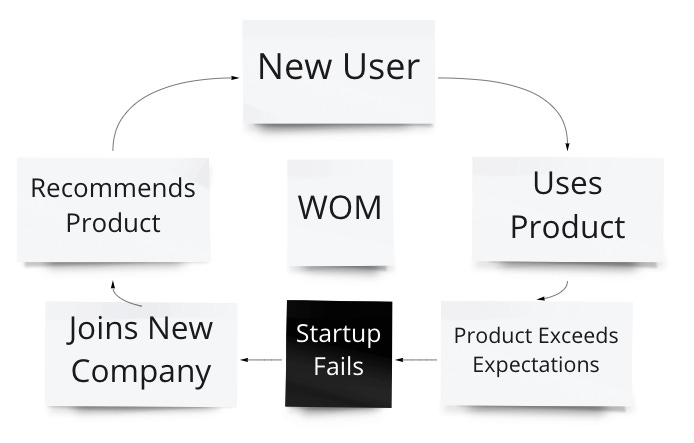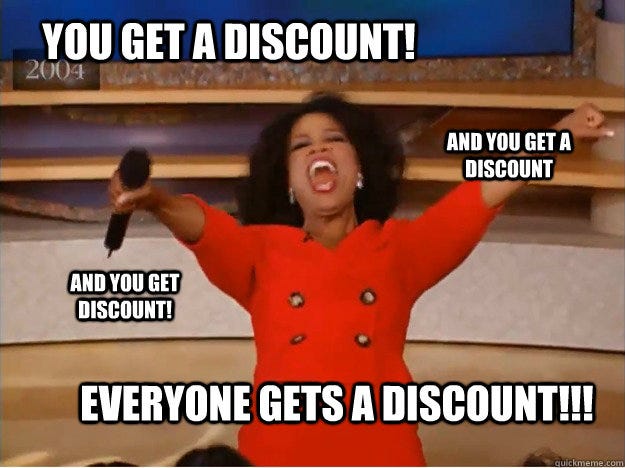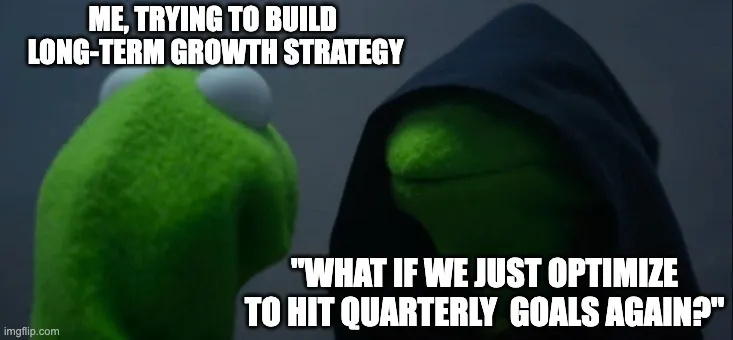by ELENA VERNA for Elena’s Growth Scope
What if I told you that there’s a growth strategy that:
A. Converts customers to paid plans at up to 60% rate, AND
B. Has proven way to land enterprise contracts, AND
C. Can build your brand within one of the most popular and trendy market segments!?
Crazy, right?
This approach does exist and it is called Startup Discount Program: And I teamed up with some of my favorite growth leaders for this article, to tell you all about it.
Startup Discount Program: What’s that?
As the name suggests, a startup discount program is a way for companies to offer their product either free or substantially discounted to newly formed companies that are a great fit for the product’s value prop, but can’t pay full price (yet). After an offer period, account is graduated to a regular, non-discounted pricing.
In a way, this is a large-scale reverse trial, just personalized for the startup market: The young companies get to experience the benefits of your product at minimal or no cost, which encourages them to integrate you into their workflows. As they scale, it’s natural for them to bring you with them. This is why this approach has resulted in up to 60% paid conversion rates across MongoDB, Hubspot, Mathrowks, post-graduation!
This approach has become an excellent distribution strategy, especially for products that are essential for early-stage teams. Established tech companies including Amplitude, MongoDB, Azure, Hubspot, Miro, AWS, Segment, and Notion are all-aboard the startup train. [Note: Check the bottom of this article to see their offers!].
However, most other companies still dismiss this tactic because of the following myths:
Common Myths That Scare People Away
Myth #1: Short term thinking trap: wanting an immediate revenue outcomes
Myth #2: Most startups fail, so it’s a waste of resources
Myth #3: Discount strategies reduce a company’s ability to monetize
Myth #4: Existing freemium or trial offerings should be sufficient
Myth #5: It would be costly to implement and sustain
If you winced as you read that list, I’ve got good news: Each of these myths is totally false. And you don’t just have to take my word for it. To give some additional context, I spoke with some startup program growth all-stars about their experience with this strategy: Ishita Jariwala (MongoDB), Olena Avramenkoa (Miro), Scott Tousley (Hubspot), and Andrew Willard (Mathworks).
Together, we’ll explain why this approach is so powerful… and provide a quick guide for how to get a startup discount program started in your business.
Myth #1: The Short-Term Thinking Trap
Every company leader is constantly facing a crucial decision: Should you…
- Work on hitting targets this quarter, OR
- Build a growth foundation for the following years?
The struggle is real.

There’s tremendous pressure to hit quarterly goals, but exclusively focusing on short-term impact will undermine your long-term growth. In particular, quick revenue gains generally come from tweaks or optimizations, while prolonged growth requires substantial adjustments and developments. This kind of lasting revenue growth involves innovation, which takes time to build, launch, and fine-tune into a revenue-generating machine. Without long-term investment, the company will eventually run out of things to optimize for short-term impact, creating a dreaded slowdown in growth.
The biggest catch with Startup Discount Program is that it’s a long-term growth strategy play – land future enterprises *now* and grow together with them, eliminating future acquisition costs and the cost of switching.
Myth #2: Most Startups Fail, So It’s a Waste of Resources
90% of startups are destined to fail. But that doesn’t mean the founders and other startup employees disappear. If someone enjoyed using your product while working at a startup, they’re likely to bring it to their new gig—whether that’s a large enterprise, a new startup, or anything in between. Don’t discount the Word of Mouth loop you are creating across employees of every startup.

“At Miro, we believe that Startups are the innovators of the world and become enterprises of the future. The earlier we enter them – the better. Even if a startup fails – we do not lose here, as they are vocal; they tell our story and provide us with feedback loops.”
—Olena Avramenko, Miro
You can further mitigate risk by establishing clear eligibility criteria for startups to participate. For instance, early stage companies affiliated with VCs, accelerators, and incubators have already been vetted and are generally more likely to survive and thrive.
“At HubSpot, we spent much time honing our startup criteria. Indeed, the majority of startups fail. However, the ones that grow to $1 billion+ valuations tend to have a common theme — they’re associated with accelerators or venture capital. Therefore, we partnered with companies like Y Combinator and TechStars to offer a discount. If you were not associated with one of our partners, you were not eligible for the discount. The reason being is because (a) VC-backed startups are pressured to scale, (b) VC-backed startups tend to scale ARR faster than bootstrapped startups, and (c) they can easily afford the core monetization offer; after the 90% discount fades.”
— Scott Tousley
Myth #3: Discount Strategies Reduce a Company’s Ability to Monetize

Offering highly targeted discounts does not diminish a company’s ability to monetize the market; instead it can serve as an effective strategy to optimize revenue streams. Tailored discounts attract specific customer segments who are more likely to convert, thereby increasing sales volume. Importantly, targeted discounts don’t necessarily condition the entire market to expect reduced prices; instead, they can create a perception of value and encourage brand loyalty.
Plus, the goal of the startup program is not to offer discounts indefinitely. Instead, the aim is to ‘graduate’ accounts to a core, non-discounted paid plan within one to five years of sign-up. Average ‘graduation’ conversion rate to a core, non-discounted, paid plan ranges from 10% to 60%, depending on your qualification parameters (according to HubSpot, Amplitude, MathWorks, and MongoDB). That is a solid monetization pipeline, standing firm against 7% freemium-to-paid or 14% trial-to-paid conversion rate benchmarks.
“At MathWorks, we view our Accelerator partners as a startup growth engine. The Accelerators provide us with a consistent flow of highly qualified and fully vetted startups we can support and advise. We know many survive, but over 35% of our accelerator startups convert to paying customers in our Startup program after the first year.”
— Andrew Willard
Myth #4: Existing Freemium or Trial Offering Should be Sufficient
Monetization models are built on top of the company’s core use cases. Packages are established based on either:
- Tiered Features (good, better, best)
- User Personas (for marketers, for PMs, for devs)
However, startups don’t always fit into these structures, for a number of reasons:
- Feature usage may be evolving rapidly
- User Personas and roles are not as clearly defined (Founders are often “wearing many hats”)
- Early stage companies have much smaller budgets compared to well-established mid-market or enterprise companies.
Because of these factors, you may need to create an alternative structure to accommodate them. An outlet in your monetization model, so to speak.
“While the product value proposition is the same, our startup users often use MongoDB to build their product from scratch. Being in the early stages is a strategic advantage as we get to optimize for new use cases rather than migrating them from other competitive solutions.”
— Ishita Jariwala
As Ishita points out, monitoring these non-standard ways that startups use products can provide your product and GTM teams with invaluable strategic insights, revealing adjacent (and innovative) use cases that might otherwise be completely missed.
Myth #5: It Would Be Costly to Implement and Sustain
Not having the resources to verify eligible startups for this type of program is usually the biggest hang-up. This is especially problematic when companies make the common mistake of expecting the program team to verify and manually track startups.
Fortunately, this issue can be solved with a similar solution to what we saw in Myth #1—set up partnerships with VCs or accelerators to outsource the vetting process.
“At HubSpot, our startup program used to run through manual verification. It was a grueling process that sucked up a lot of the team’s energy. We then built an in-house verification system where we gave unique codes to our partners, which they shared with their portfolio companies, and that’s how we validated our startups. The manual verification process was sticky at first, but as the program was validated with healthy LTV: CAC ratios, it justified investment in the technology for automated verification.”
— Scott Tousley
“Previously, at MathWorks, we deliberately defined the startup verification process that did not depend solely on the program team. We built it into the sales qualification process. We built the operations with marketing ops to ensure we can accept and track them in the system.
At MongoDB, we currently support startups at accelerators and VCs – thus leveraging the verification of startups to them .… We were able to scale our startup program initially without spending any $ of marketing budget because many accelerators let you add your offer to their startups at no cost – also, the ROI is higher because you are working with “vetted” startups. Additionally, when the program pivoted to have venture/accelerator-backed startups – the ROI doubled compared to having a program open to all.”
— Ishita Jariwala
“Startup program is costly? I doubt it! Our year-old Miro startup program is run by one full-time person and one part-time contractor. Currently, it has outstanding traction of 6,000 Startup approved; 450 partners in-network; our Startup NPS is 84.”
— Olena Avramenko
Okay, Myths Busted. But How Do You Get Started?
Hopefully, addressing the above myths around this type of program will convince you (and other company leaders) that this sort of program is worth exploring. But how do you actually execute? Below is the 3-step guide on how to hit the ground running.
1. Structure the Offer
Start with creating a prototype of the startup offer that combines product and service. Choices for initial product offers include:
- Giving products entirely for free via credits: Amplitude, Miro, MongoDB, Segment
- Providing discounts on your standard pricing: Hubspot, MathWorks, Intercom
Layering human touch on top of the product could help maximize your investment, especially if there is high friction to activation or the community aspect is essential. Consider offering product advice through human touch-points, self-service content, or dedicated support and events.
“At MongoDB, we support startup offer through our startup technical advisors- and this has helped maintain a very healthy conversion rate even after the program free credits end, a low churn, and a significant ARR growth.”
— Ishita Jariwala“For Miro, there are three most critical “human touch” moments. We have: [1] our bi-weekly live onboarding sessions for new Startups in the program, [2] community events on the topics relevant for startups, [3] in-person onboarding sessions for every new partner”.
— Olena Avramenko
You can also use the following tactics to increase the likelihood of these startups converting to long-term paying customers:
- Communicate the exact value of the free offering (via credits or discounts) and redemption timelines, so the customer understands the future cost upfront (Amplitude, Miro, Segment )
- Introduce graduation discounts each year to ease startups into regular pricing (Hubspot, MathWorks)
“After over six years of providing discounts to startups, in 2022, we launched a new Startup specific offer that provides engineers with access to the full suite of our tools at a startup-friendly price that can last up to 5 years. Our goal was to remove barriers to adoption and provide users tools and support they need to innovate at an accelerated pace. We have seen this result in over 50% increased growth of average sale at a startup, deeper adoption due to the generous timeline, and happier startup customers.”
—Andrew Willard
2. Grow
The first place to start is obvious: Do you already have startup companies in your pipeline? They might be freemium users or prospects captured from lead gen activities. You can move these organizations along by inviting them to your new program! To scale the distribution strategy further, leverage the partnership approach mentioned in Myths #1 and #4, above:
- Incubators and accelerators (recommended to ease qualification)
- Platforms [e.g. f6s.com], startup perks [e.g. Product Hunt Founders club], and communities
“At Miro the big bet from the beginning of the program was that we will grow through partnerships with accelerators and incubators. The first month we did outbound to 20 partners, they all were happy to join, and because they shared our partnership announcement on their social [that was a part of the agreement😉] this brought another 20 partners in 2 weeks. From this time, we mostly worked with inbound requests, and in 1 year, we added 450+ partners. We track progress for each partner and prolong our partnership if it meets metrics.”
—Olena Avramenko
3. Measure
Focus on the following key metrics to start measuring the impact of the startup program:
For Startups: Number of new startups, Number of total startups, Product usage growth, Graduated startups (converted to core monetization model), Startup NPS
For Accelerators: Number of active partners and cohort penetration rates
As the program matures, add revenue as another critical outcome.
“Portfolio penetration within our top partners was an essential metric because of the word-of-mouth loops that would spin within accelerators. For example, if there are 50 Y Combinator companies, 1 of them is shopping for a CRM, they ask 10 of their portfolio peers, and eight say they use HubSpot … that is extremely powerful. We also focused on the valuation growth of companies in our program, which we leveraged for storytelling. This told the stories of ‘seed to Unicorn’ valuations as our $1 billion+ valuation companies had been HubSpot customers since the early stages.”
— Scott Tousley
Conclusion: Winning the Long Game
Yes, this approach is amazing, but it requires a difficult perspective shift: While prioritizing initiatives that impact this quarter is essential, we can’t lose sight of building for the long term. As you consider whether a startup discount program is right for your business, remember that the benefits compound over time:
- Creating a sustainable growth engine for your business
- Ensuring relevance with new, emerging enterprises
- Building your brand with the startup community
Want one more reason to try it out? Startups are often building exciting, potentially world-changing products and by offering this kind of program, you get to join in the mission!
BONUS: Free Stuff for Startups!
Don’t miss these great startup offers (eligibility criteria vary, so read the fine print):
Miro → $1000 in credits / 20% off
Amplitude → Up to $40K in credits
MongoDB → Free atlas credits
Hubspot → Up to 90% off
Notion → $1000 in credits
Segment → Up to 2 years free
Dropbox → Up to 90% off
Google Cloud/Firebase → Up to $200K off
GitHub → 20 Free seats
Microsoft → Free OpenAI credits and $150K Azure credits
